Scientists vote to fix the world’s weight-loss problem
The kilogram as people know it will soon change forever
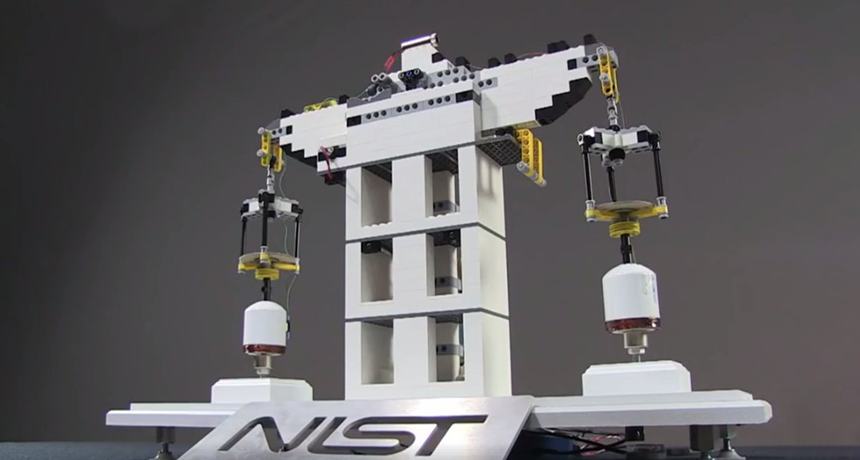
Starting in May 2019, the kilogram will be defined by measurements from a device called the Kibble balance. This is a LEGO model of that device, at the National Institutes of Standards and Technology.
NIST
[NOTE: This story has been updated (see bottom) to account for the vote.]
November is election time, and not only for voters in the United States. On November 16, hundreds of scientists will gather in Paris, France, for the most unusual election this year, if not this century. Maybe ever. The voting scientists won’t be choosing new leaders or passing new laws.
They’ll be voting on something more elementary: a definition.
If the vote passes, they’ll permanently change the meaning of the word kilogram. The change will help scientists and engineers measure more precisely. Experts have been preparing for this vote for a decade. It they have done their job, they’ll fix a looming problem — and the rest of the world won’t even notice.
“I will go, and I will vote,” says Peter Mohr. He’s a physicist at the National Institute of Standards and Technology (NIST) in Gaithersburg, Md. He is also to blame, at least partially, for the vote. Twenty years ago, Mohr helped write papers arguing that the kilogram needed a new definition.
He expects the vote to pass with flying colors. “Hopefully there won’t be surprises,” he says. “But you never know.”
To understand why changing a kilogram is a big deal, you have to consider what the word means now. And to understand that, you have to visit a secure vault in Europe. This quiet, small room is opened only once a year.
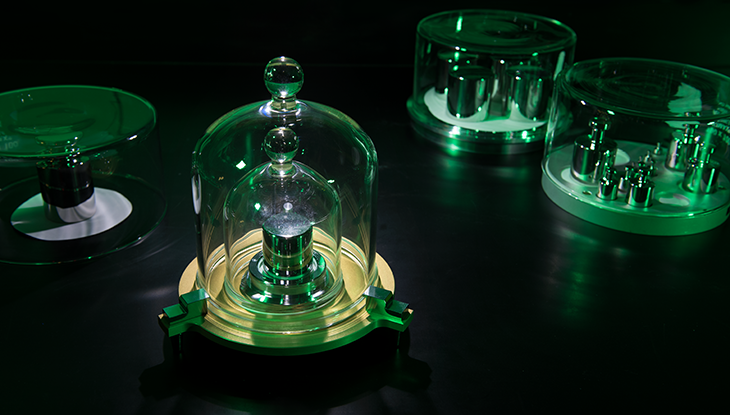
The kilogram
The underground vault is in Sèvres, France, close to Paris. Inside lies an unusual treasure nicknamed Le Grand K. It’s also known as the International Prototype of the Kilogram, or the IPK. It’s a squat cylinder made of polished metal. It stands about as tall as someone’s thumb, and has a diameter equal to its height. It sits inside a vacuum-sealed bell jar and no bare hands ever handle it!
To unlock the vault requires not one but three keys, each in the possession of a different person. Hao Fang doesn’t have a key, but she has been inside the room. She’s a physicist at the International Bureau of Weights and Measures, which takes care of Le Grand K. Every year, she’s part of a small group of scientists who enter the vault to visit the cylinder.
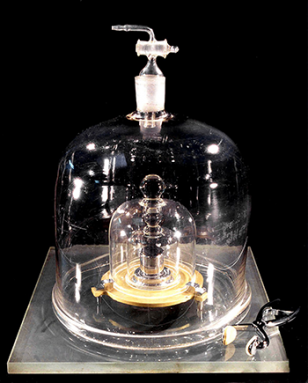
“It’s a small room, with lots of sensors,” she says. “We only stay a short time because we don’t want to disturb the environment. We check that everything is okay.”
That may seem like a lot of bother, but Le Grand K isn’t just any ordinary cylinder. Every time you weigh something or measure its mass, the accuracy of your measurement depends on Le Grand K.
That’s because this curious and shiny little doodad is the exact definition of a kilogram — at least until November 16.
Kilograms are used to describe the mass of an object, which tells you how much matter the object contains. A bowling ball has a mass of about 5 kilograms. A basketball has a mass of about 0.5 kilogram. If you compare those two numbers, you can confirm what you already knew from picking them up. A bowling ball contains more matter than a basketball.
If you live somewhere that measures mass in pounds, the new change will affect you, too. That’s because a pound is defined as 0.4536 kilogram. That bowling ball is 11 pounds. And the basketball is 1.1 pounds. And this means that if the definition of a kilogram changes, so does the definition of a pound.
By our current definition, noting that a bowling ball has a mass of 5 kilograms is the same as noting that it contains exactly five times as much matter as Le Grand K. (But of course, we don’t learn it that way, or say that. We don’t say that because it’s a lot of words, and because it sounds ridiculous.) Every mass measurement, no matter where it’s done or what it’s done on, no matter how big or how small, traces back to Le Grand K.
And that’s a problem, say experts. If you define a unit with a physical object like Le Grand K, you have to consider some strange problems. For example: What if something happened to the cylinder?
“If someone dropped the IPK, the mass of the world would change,” says Stephan Schlamminger. He’s a physicist at NIST who is working on the new definition. In a split second, he notes, “everyone will have the wrong measurement.”
But this situation should change soon. Scientists are expected to vote to no longer define a kilogram as the mass of Le Grand K. Instead, a kilogram will be defined according to a mathematical formula that uses a natural constant of the universe. It’s called Planck’s constant. A constant is a number that doesn’t change. Planck’s constant is a number that shows up when scientists study quantum mechanics. These are the rules that describe the behavior of subatomic particles.
Is this the first time scientists have decided on a new definition for the kilogram?
No. The quest for a precise unit of mass has a long history. Historians know the Romans had a system of weights and measures, for example. But at the end of the 18th century, scientists all over the world were becoming frustrated because units had different values from country to country.
In 1799, during the French Revolution, scientists adopted a specially-designed copper metal bar as the definition of one meter (3.3 feet). A small platinum cylinder became the definition of one kilogram (2.2 pounds). The cylinder represented the mass of 1,000 cubic centimeters of water near its freezing point.
Those two objects represented the beginning of the metric system. In 1889, scientists from all over the world came to Paris for a meeting to agree on units that they would all use. It was called the General Conference on Weights and Measures. That’s the same group that will meet and vote this month. (Though with different members, of course.)
The metric system is still the most commonly used system in the world.
What is the metric system anyway?
The metric system is a measuring system that uses seven so-called “base units.” They are part of the International System of Units. It’s called the SI system for short. The meter and kilogram are two base units. The others include the second (time), the kelvin (temperature), the ampere (electric current), the candela (intensity of light) and the mole (numbers of molecules).
One feature that makes the metric system special is that it is based on the number 10. For instance, 10 millimeters make up a centimeter. And 100 centimeters (100 is 10 times 10) make up a meter.
I’ve never heard of some of those base units.
If you keep studying science, you will meet them all.
I live in the United States, and we measure length in feet or miles, and weight in pounds. Why should I care?
The United States doesn’t use the SI system. Instead, it uses “customary units.” In this system, length is measured using units like feet and inches. People measure weight in pounds. This system isn’t based on the number 10. For instance, 12 inches make up a foot. Three feet make up a yard. And 1,760 yards make up a mile.
These customary units are, however, defined by SI units. A pound is exactly 2.2 kilograms, for instance. So changing the definition of the kilogram will change the definition of a pound.
That sounds incredibly confusing. Why doesn’t everyone just the same system?
It’s hard to teach an old country new units.
Fine. Do scientists still use a copper rod to define a meter?

No. Like the kilogram, the meter has a history of scientific debate that goes back hundreds of years. In 1960, scientists voted to retire the copper rod. They recognized that if the rod changed, even a little, the definition of the meter would change. For example, what if an earthquake knocked the rod around, and it lost some atoms?
They changed the definition of a meter to the length of electromagnetic waves produced by a form of the element krypton called krypton-86. Krypton-86 is radioactive. That means it emits energy in the form of waves.
Two decades later, scientists changed the meter again to be even more precise. They connected it to the speed of light in a vacuum. That speed of light is a natural constant. It never changes and can be measured precisely. In one second, light travels 299,792,458 meters (186,282 miles). Since 1983, a meter has been equivalent to how far light travels in 1/299,792,458th of a second.
You mentioned a bunch of other units.
Five, to be exact.
Let me guess. They’re also up for a vote?
Some are. Metrologists want…
Stop! What’s a metrologist?
Metrology is the study of measurement. A metrologist is someone like Hao Fang, a scientist interested in how we measure things.
Okay, got it. Continue.
So metrologists like Peter Mohr, Hao Fang and Stephan Schlamminger want to link all the SI units to fundamental constants.
Like the way the meter is connected to the speed of light.
Exactly. In November, in addition to the kilogram, scientists will vote on new definitions of the kelvin, the ampere and the mole. All of those units are tied to natural constants. However, the kilogram is the only unit that’s still connected to a physical object, Le Grand K.
What’s the name of the natural constant used in the new definition?
Planck’s constant.
I don’t know what that is.
It’s named after Max Planck, a German physicist who won the Nobel Prize in physics in 1918. He showed that energy transmitted by photons — the particles associated with light — can exist only in small packets called quanta. Planck’s constant connects that energy to the wavelength of light. You have to study quantum mechanics to find out more, but it’s worth the trouble.
Let’s get back to Le Grand K. I have more questions about this shiny cylinder.
Fire away.
What’s it made of?
It’s 90 percent platinum and 10 percent iridium.
Is it the only one of its kind?
Yes and no. The IPK in France is the official kilogram. But many countries have their own copies. Each copy is engraved with a number. Nations can use those copies as a national standard, so metrologists don’t have to go to France every time they want to check their work. Checking a mass against any of these standards, though, is cumbersome. And that’s only one of the problems with using Le Grande K as the standard for the kilogram.
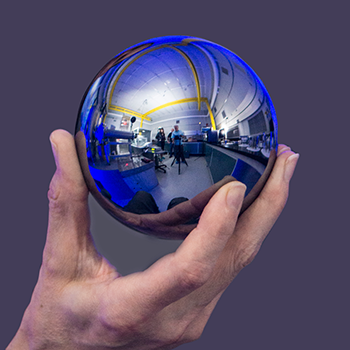
What are the other problems?
Every few decades, scientists open the vault to clean and check the IPK. It’s a long and drawn out process of steam-cleaning, and you have to handle the cylinder with special tweezers and gloves. It was during one of these checkups, in 1993, that scientists found a big problem. When metrologists compared Le Grand K to its official copies, the found that the copies all weighed more than Le Grand K. That meant that either they’d all gained mass, or Le Grand K had lost some. But if Le Grand K had lost mass, then the definition of the kilogram had shifted.
That’s not only a problem for people who want to measure kilograms. “Other units depend on the definition of the kilogram,” says Fang. “So if the IPK changes in mass, the other units also change. This is a problem.”
Can another definition for the kilogram overcome these problems?
Scientists have been debating that for decades. They’ve proposed many ways to redefine the kilogram. One involves using perfect spheres made of silicon. By counting the atoms in a sphere and using a mathematical equation, they can measure Planck’s constant. These spheres have played an important role in the process of the redefinition.
Schlamminger, though, notes that a silicon sphere has the same problem as Le Grand K. “It will become the artifact,” he says. “And we’re always worried about using the artifact. You may destroy it. Or change it.”
Instead of the silicon spheres, scientists have chosen a different way to measure Planck’s constant — and thus redefine the kilogram. It’s called a Kibble balance.
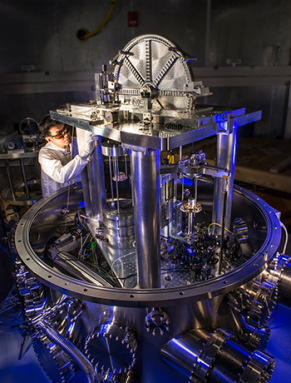
Kibble, as in pet food?
No, Kibble as in Bryan Kibble, the British physicist who invented it. He died in 2016. The Kibble balance (previously called the Watt balance) is a scale, but it’s not like one you use in the bathroom. It uses electricity and magnetism to balance the weight of a small object. Measurements taken during that balancing act can be used to find Planck’s constant. Once Planck’s constant is determined, the scale will have been calibrated. Then, scientists can use the Kibble balance — and some mathematical equations — to determine the exact mass of an object.
Why is this better than the IPK?
The fact that the kilogram will no longer be a physical object provides several advantages. “The Kibble balance is a machine, and the more you use it, the better you get at it,” Schlamminger says. He should know: He’s spent years helping to design and test the latest version of the machine.
Also, there’s more than one Kibble balance. NIST has one. So do Canada and Switzerland. France has two. More will surely be built. That means there will be no need to travel to one place to determine an official mass. And because a balance can determine mass for objects of different size, scientists will be able, with high precision, to measure things that are much smaller and much bigger than a kilogram.
So what will happen when the kilogram changes from one definition to the other?
You won’t notice anything different. Scientists will officially adopt the value of Planck’s constant. From that point on, they’ll use that value to determine mass. They will turn to the Kibble balance to figure out the mass of an object instead of making a comparison to the IPK.
What will happen to Le Grande K?
“We will keep it for historical interest,” says Fang. “But it will no longer have the role of the IPK.” It won’t be shelved immediately, though. Fang points out that the Kibble balance is a complicated machine that requires a lot of time and people-power to operate. In the short term, the IPK and its sisters around the world will remain easier ways to measure mass.
And the change won’t officially go into effect until May 20, 2019. That day is celebrated as World Metrology Day because it marks the day in 1875, in France, when scientists agreed to use the same units in their scientific measurements.
How should I celebrate?
Measure something!
Update: On Nov. 16, 2018, the International Bureau of Weights and Measures issued this statement: “Today, in a landmark decision, representatives from 60 countries voted to redefine the International System of Units (SI), changing the world’s definition of the kilogram, the ampere, the kelvin and the mole, forever.” In fact, representatives of only 54 nations were present for the vote, notes
Fiona Autry. But they unanimously gave their consent during a vote at 1:40 p.m. Central European Time, she add. Autry works for Britain’s National Physical Laboratory.
(Note: This story has been corrected for an earlier typo in describing the relationship between the cylinder’s size and the mass of water it equaled.)







